Inuit Culture - The Iglu and Its Secret
By: Fr. Franz van de Velde OMI
The spelling of the Inuktituk words is kept that of the author, as well as his use of the word "iglu" instead of "igloo". "Iglu" is an exact spelling of the word as it would be used in a text written in Inuktituk.
What Is an Iglu?
A person should start by asking what is the proper interpretation of the Inuktituk word iglu. It is an interior space... a closed-in space... a limited, protected space... a covered dwelling... etc.
By this definition during the cold winter period, a polar bear den is an iglu. A siksik (arctic ground squirrel) buried in the ground, spends the winter in an iglu. A natural cavity in the ice or a grotto in the rocks is, again, an iglu and, in the winter an Inuk lives in an iglu. It seems then to me that the word iglu is more generic than specific. In common usage, however, the word iglu or igloo represents nothing else than the Inuit snow-house for most non-Inuit. For the Inuit a white man lives in a iglurdjuark (a big house/iglu).
Let me tell you now that an Inuit iglu is built with snow and not with ice. Theoretically it would be possible to build an iglu with any material. Fr. Fournier and some friends built a very large iglu at Igloolik, with stone, rock and cement. It, however, took him an entire summer to complete. The Inuit need the iglu for shelter the same night.
The Family Winter Camp Iglu
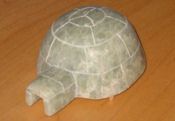
There are several ways to erect an iglu. I will begin by describing the classic large family winter camp iglu.
Testing of the Snow - Using "Sabgut"
First, the man locates a proper snow bank which is sufficiently deep to enable him to cut the building blocks (aoverk) vertically. To evaluate the consistency of the snow he uses a snow tester (sabgut). This is a caribou antler rod 70 to 80 cm long. One end is tapered to a rounded off point. The other end has a round handle (kangeark) of about 5 cm in diameter. To test the snow he gently presses down on the handle and feels the snow's consistency. What he is looking for is snow formed from only a single storm. Snow formed during a more recent storm would split apart from the harder snow surface of an earlier storm so it would not provide the most stable building material.
Cutting of the Snow-block and Building Process
The builder cuts all of the blocks at the same site where he is building. In this way he creates a pit where he stands. He builds his shelter above himself and the pit.
The construction is done in the form of rectangular blocks built in a spiraling circle upwards which finishes with the placement of a final “key” block at the top. The base of the spiral always inclines inwards causing the snow-blocks to lean inwards. This base is also inclined slightly downwards. This makes the snow-blocks naturally slant downwards until each one rests on the preceding block. To give a block the proper shape the Inuk cuts and shaves it with his snow-knife (pannak). After each additional snow-block is added the base of the spiral inclines slightly more inwards. The last “key” block for closing the top of the iglu is almost vertical in shape. A person who understands the reasoning and interaction of the two spiral inclinations will be able to build an iglu. Many times a person who has not personally seen the building technique will be unsuccessful in building an iglu.
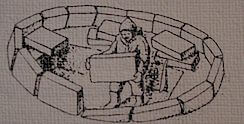
To begin the process, the man cuts a straight line as deep as the snow-knife permits within the circle of the future snow-house. He then cuts a second line parallel to the first one. The distance between the two will be the length of the snow-block, approximately 70 to 80 cm. Next, he cuts a line to join the two parallel ones. Then a second transversal line is cut at approximately 10 cm distance. This will constitute the thickness of the snow-block (aoverk). He returns to the first transversal line, stabbing and cutting towards the bottom of the second transversal line to detach the block base from the snow-banks. The first block is, consequently, detached on all sides and can be lifted out. Now a third transversal line is cut at approximately 10 cm distance. Both ends are cut as deep as he can and along the full length of the block base. The block now hangs on the snow-bank side. The three other sides are free and detached. With quick, deep stabs all along its length, the builder detaches the fourth side. The block falls down because it hangs a couple of centimeters above the base. The block can be taken out and be put in its place in the circular iglu base. This process is repeated as he proceeds to fill out the circle. All of these blocks are already slightly inclined inwards.

To begin the spiral he cuts an inclination along the blocks already laid out in a circle and starts the second row of blocks spiraling upwards. The base of the spiral is cut gradually and inclines steadily downward and inward. If scaffolding is required he uses superimposed snow-blocks to reach the top of the iglu and to close it with the top “key” block.
The scaffolding material and leftover snow blocks will be used to build an elevate platform in the iglu. This will take up two-thirds of the surface area and will be approximately three feet high. This platform is known as the bed (iglerk). On the left side there will be another elevation on which the seal oil lamp, food, meat and fish, will be placed. This elevation also serves as the table for the wife. In front of this table is the wife's space. In a situation where a second couple occupies the same iglu a second elevation will be built for the same purpose on the iglu's opposite side.
The Work After an Iglu Is Built
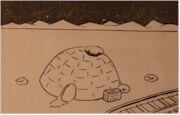
When the other inside work is completed, a gothic shape opening of approximately 70 cm high is made in front, and always lower than the iglerk (bed platform). The reminder of the iglu interior surface becomes the floor.
Next, the man builds a smaller iglu leaning on to the big one. The same building method is used. This iglu will be the porch, shed, refrigerator, deep-freeze, etc. It's floor will be approximately 10 cm lower than the floor of the main iglu and it will be less insulated.
Then the wind-break is built. This wind-break, two or three blocks in length and height, has a form of an extended semi-circle.
While the man, and possibly a helper, are building from the inside, his wife and daughters work outside shoveling snow onto the walls. Soft, or pulverized snow (shaaksak) is used for this. A layer of 30 to 40 cm of this snow is shoveled onto the base of the iglu wall. This layer will gradually become thinner until nothing is shoveled onto the roof. This snow layer insulates the iglu.
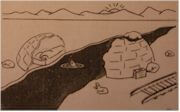
The frame of the snow-shovel (puagri) was made from the caribou antler. Pieces of seal skin were attached to this frame to make the blade of the shovel. The base of the frame was sharpened and the shovel had two handles. One handle was on the top and the other was in the middle. Both hands were used for shoveling. More recent home-made snow shovels are made with thin, light wood.
Sometimes another small shelter is constructed where the porch leans to the main iglu. Its form will be an open half circle on approximately 1 meter in diameter. It serves as a bathroom.
Placing the Window
Before the iglu is completely finished the family has to take care of the lighting. It is not dark in an iglu because some diffused light comes through the walls. To make it nice and bright people install a window. A piece of fresh water ice makes a clear, transparent window whereas sea or salt water ice is opaque. I have seen people that moving from the land to the sea ice camp take along the window from their abandoned iglu. Some have larger windows while others have smaller ones. On the average the rectangular window is 50 by 60 - 70 cm, with well rounded top corners and slightly rounded base corners. It is installed from the outside and located above the entrance doorway. During the night, and sometimes during the day, frost develops on the inside of the window. In the morning this frost may be scraped from the window with the pannak or the ulu. When children and young people can reach the window, they use is as a blackboard to make drawings and to write on. It is really unfortunate that all of those artistic drawings melt away. Who knows what masterpieces have disappeared... Not unlike those from other peoples which have been discovered in grottos!
The man who cuts the ice piece for the window searches for the place free of snow and when deep crack already exists. This crack will be one of the four sides of the window. With the ice chisel (tuuq) he draws the outline of the window. Slowly, delicately he cuts around this outline. He makes it deeper and deeper while slanting the chisel more and more underneath. He continues to delicately cut further underneath the ice. At a certain moment the whole piece of ice for the window jumps free he places the ice window onto a snow covered place and start to scrape it smooth on the underside and the corners. This future window can be 8 to 10 cm thick and to cut it is a real “art”. An uninitiated person always wants to go too fast and eventually breaks the window provoking smiles from the people who are watching nearby.
Inside the Iglu

The lady goes inside to do her work. Baggage has to be pulled inside. She levels off the bed platform. Skins are beaten with snow-beaters to keep them perfectly free of snow and to prevent them from becoming wet. The woman beats the skins by holding them head side up at the height of her chest. She beats them clean while gradually rolling them up and, then, puts them aside. The snow beater (anautaq) is a small special stick of caribou antler. Once all of the skins are beaten clean they are spread on the bed platforms. The thick, heavy ones are placed with the fur side down on the snow. Over these skins another layer of skins is placed, with the fur side upwards. The sleeping bags, both communal and individual, are placed on top of these skins.
Next, the woman has to install the seal oil lamp (kullik) on the elevation in front of her “wife's place”. She will then put her small amount of personal belongings beside her place. They may include a bag (ikpiaaqjuk) made from a yellow billed loon skin.
Sometimes she places birch twig mats on the snow under the first caribou skins. These twigs are to be found at the estuary and banks of some big rivers. They are intertwined and held together with caribou sinew (ivaluq) or with the seal skin robes (akslunak). I have seen polar bear skin used when they have no mats. Usually the caribou skins which are used for bedding are the large back skins with heavy winter fur.
The seal oil lamp is placed on top of three pegs stuck in the snow in front of the wife's place. In walrus country those pegs will often be made of the penis bone (usuaq) of the male walrus. Elsewhere they will use anything that is available. Behind the lamp you will find the food, fish, meat and blubber.
The drying rack (initaq) hangs over the seal oil lamp. It was made of the caribou antler framed with rope strung across similar to a net. All things for drying... mitts, socks, diapers... etc., are hung on the initaq. The initaq hung on the rope from the ceiling and rested on the tent pole which was pushed through the iglu wall and weighed down outside with the block of snow. The tent pole will permit them to hang a cooking pot on it or one for melting water. To make the water the woman melted ice. It melts twice as fast as snow. On the trail that fact is well remembered in order to conserved primus stove fuel.
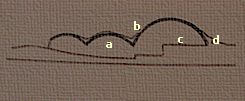
Eastern Arctic Igloo - drawing by Fr. Guy Mary-Rouselliere OMI
- front porch
- soft ice window
- platform bed
- outside insulation
How to Repair an Iglu
It can happened that the iglu ceiling begins to melt and drip. Then the ceiling is scraped smooth again, and instead of dripping it flows to the walls. The bedding is protected by putting a seal skin under where the scrapings fall. These scrapings are discarded. Sometimes, someone is sent outside to remove the snow which may have accumulated on the roof as it results in needless insulation and overheating. Another way to make a temporary repair is to place a piece of snow where it is dripping. This acts as a sponge and absorbs the water. When a person forgets about a dripping roof, it can be very treacherous. Due to the weight of the snow-blocks, they can fall down when soaked. Drippings may fall on your head or down your neck. I can assure you that this is very disagreeable feeling and it provokes a bust of laughter from everyone else present. The victim, then, usually tries to laugh also!
After living in the iglu a while, the roof and ceiling become glazed... Ice is cold. Usually it is abandoned and a new one is built. Sometimes, instead of building anew, a thorough repair job is done.
Quite often, in the large family iglu, a person can notice a little ice dome on the top of the roof. That ice dome may be 50 cm in diameter and up to 25 cm deep. It looks like a big upturned glass pot without handles. In its center is a little hole for aeration.
Where to Build?
Usually Inuit preferred to build their snow-houses on the sea ice. When traveling or camping inland they would try to build on a lake. The reason is that the iglu will be less cold and easier to warm up. Under the ice there will be just so many feet of unfrozen water. On the land there will by just so many feet of permafrost... frozen deep. If, out of necessity, the iglu is to be built on the land, Inuit look for very deep snow-bank in order to have as much insulating snow as possible under iglu's floor. On the lake there is advantage of not having to melt ice for water. It could be obtained directly from the lake on which iglu stands. The man builds a water pit (imertarvik). With his ice chisel (tor) he makes a hole and reaches the water. Around that hole he places a few snow blocks as a windbreak. On top of the hole he places a couple of snow-blocks to insulate it from the cold. Whenever he would need water the top crust of ice in the hole will be only a few centimeters thick. This saves a lot of work...
The Secret

How often I have heard Inuit say that in calm and windless weather the iglu was cold and less comfortable compared to when there was a wind! They are perfectly right and the explanation is found in the “secret of iglu”. As mentioned before there is a semicircular windbreak in front of the opening to the iglu. The wind races over this windbreak, the air behind the windbreak is pulled along with the racing wind, thus producing a vacuum. That vacuum runs through the porch and inside the iglu where it neutralizes the natural inclination of heat to rise. Consequently, a comfortable atmosphere of warmth of approximately 2 - 4 degrees is held above the platform bed. The outside cold from the top of the iglu and the lower vacuum warmth prevents the top of the iglu from melting and holes from forming. It is for the same reason that the floor of the porch iglu is lower and than the one of the main iglu and, also, that the entrance openings are always lower than the platform bed. It is a simple principle and needs only to be seen and applied.

